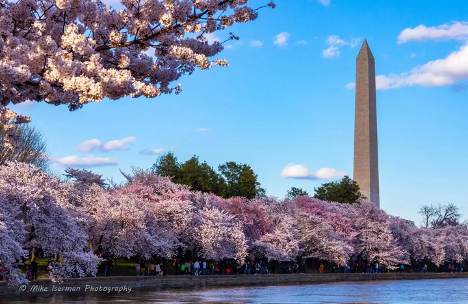
The blooming of the cherry trees around the Tidal Basin in Washington, D. C. has come to symbolize the natural beauty of our nation’s capital city. The famous trees, a gifted from Japan in 1912, signal Washington’s rite of spring with an explosion of life and color that surrounds the Tidal Basin in a sea of pale pink and white blossoms. Thousands of city residents and visitors from across the nation and around the world come here to witness the spectacle, hoping that the trees will be at the peak of bloom for the Cherry Blossom Festival. On average, DC’s cherry blossoms bloom around the last week of March into the first week of April. But it varies year to year based on weather conditions, so it can also be a little before or after that period. This page tracks the latest information on the coming DC cherry blossom bloom. On March 1, the National Park Service predicted that peak bloom would occur around March 22-25.
Peak Dates: March 22-25, 2022
Location: Tidal Basin Area in Washington, D.C.
Address: 1275 K St NW, Washington, DC 20005
History of the Cherry Blossom Trees and Festival
Cherry Blossom Festival, which runs every year from March to April, commemorates the gift of approximately 3,000 cherry trees from the Mayor of Tokyo to the United States in 1912. The gift celebrates the friendship between the Japanese and American people. The Cherry Blossom Festival, located mainly around the Tidal Basin, attracts hundreds of thousands of people to D.C. each year. Peak bloom occurs when 70% of the Yoshino Cherry trees are open. Most people are familiar with the beauty of the cherry blossom trees; but few know the history of how these trees came to surround the Tidal Basin. That story starts with an individual buried at Arlington National Cemetery.
Often overlooked and forgotten are the first President and First Lady to be buried at Arlington National Cemetery —President William Howard Taft and his wife Helen “Nellie” Taft. In 1909, Mrs. Taft received a letter from Mrs. Eliza Ruhamah Scidmore, a local author and member of the National Geographic Society, detailing a plan to plant cherry trees around the Tidal Basin. Mrs. Taft responded to the letter by agreeing to the overall plan; but she suggested some minor changes to the layout of the trees around the Basin. The Japanese consul was told about the plan and offered to donate approximately 2,000 trees. In 1910 the trees arrived in Washington DC and the Department of Agriculture discovered that they were infested with insects. A few days later President Taft agreed to have the trees burned. The mayor of Tokyo and others from Japan decided to donate another batch of cherry trees to the Capitol. In March of 1912, approximately 3,000 trees arrived in the District.
Mrs. Taft and the Japanese ambassador’s wife planted the first two saplings on the northern bank of the Tidal Basin. Those trees still stand today with a small plaque commemorating the event. If you want to avoid the crowds at the Tidal Basin, come to Arlington National Cemetery to see a variety of Japanese cherry trees including: Yoshino Cherry, Akebono Cherry, Weeping Cherry and other blooming trees like magnolias, dogwoods, red buds and Japanese crab apples. And while you are visiting, don’t forget to stop by section 30 to thank Mrs. Taft for her role in bringing the cherry blossom trees to Washington D.C.!

